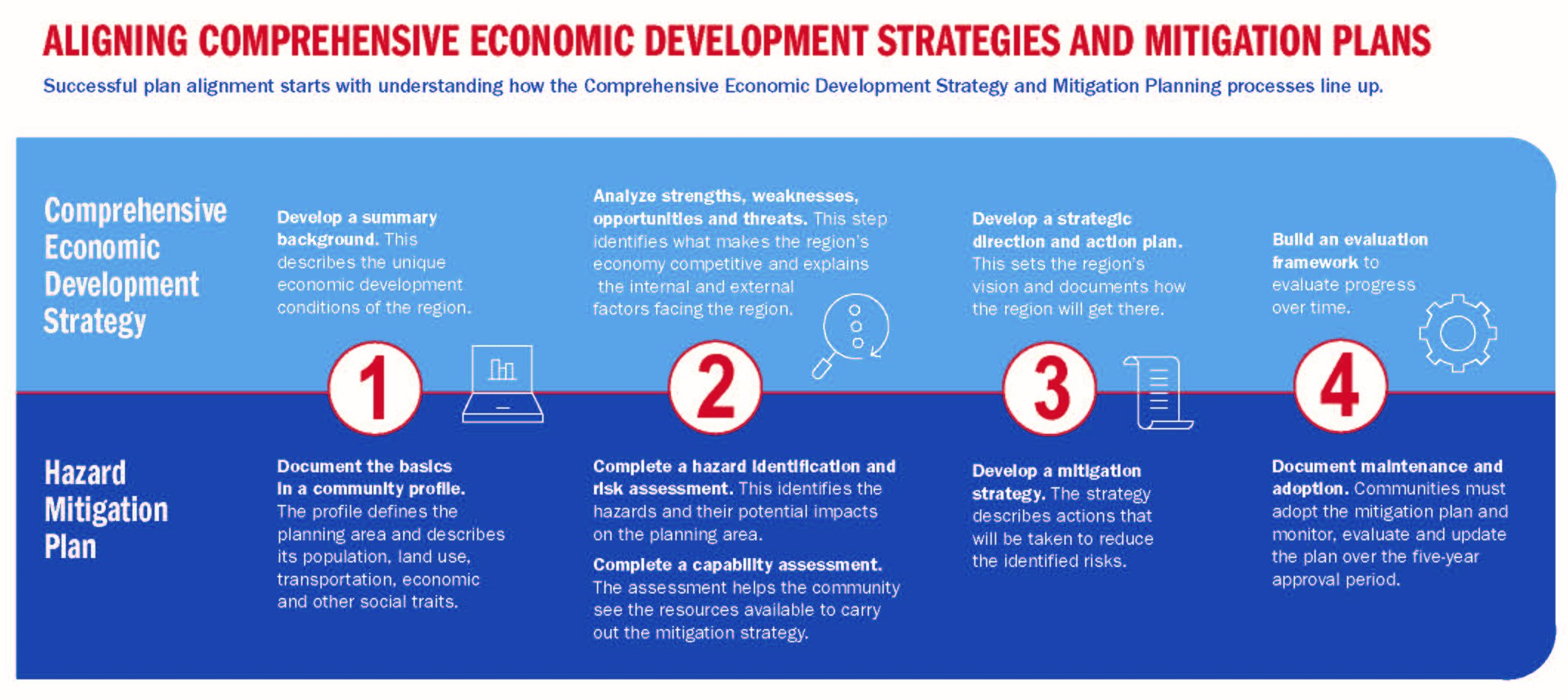Our nation faces more frequent and severe disasters every year. Hazard events are getting more powerful because of climate change. Focused planning can help communities prepare for and meet these growing challenges. FEMA helps communities with hazard mitigation planning. EDA helps with Comprehensive Economic Development Strategies or CEDS. The two plans can support each other. Aligning them will link strategic priorities, leverage funding and invest in actions that reduce risks.
The CEDS and Hazard Mitigation Plan Alignment Guide shows how economic development and hazard mitigation planning can support each other. It builds on EDA’s requirement for a CEDS to consider economic resilience.
It also builds on earlier work by EDA and FEMA. Key resources include:
- EDA’s CEDS Content Guidelines.
- FEMA’s Local Mitigation Plan Review Guide and future updates.
- FEMA’s Local Mitigation Planning Handbook.
The Guide includes economic development concepts to add to a hazard mitigation plan. It lists hazard mitigation ideas to include in the CEDS. Aligning these federal planning tools can make local planning more meaningful and inclusive.
Successful plan alignment starts with understanding how the two processes line up, shown in Figure 1.

Making the Case for Plan Alignment
Plan alignment increases collaboration and coordination between leaders, agencies and departments. This results in better-informed and more efficient planning that protects communities from a range of hazards. The CEDS’ focus on economic resilience works well with hazard mitigation goals. An economy’s resilience may help communities withstand and recover more quickly from a shock. It lessens the effects of disasters on workers in industries subject to economic uncertainty. It can also protect tax revenue and the tax base from losses.
In the same way, a hazard mitigation plan assesses risks to key assets. These assets include the economy, population, critical infrastructure and lifelines, natural and cultural resources and capabilities.
At the regional and local levels, people skilled in economic development can be active partners in building economic resilience. Those who know hazard mitigation can help identify hazards, find solutions and reduce long-term risk. Together, they become a focal point for coordination, sharing information and responding to external questions before and after a disaster.
Communities that align plans may have more options for federal, state and local funding and other resources. They can also use the funding and resources together in creative ways to improve outcomes. Aligned plans can improve management of federally funded grants. This will help solutions have greater and more lasting impacts.
Aligning plans builds buy-in for activities that support safer, more resilient communities. When plans are aligned, information is more readily shared across the whole community.
When communities align their CEDS and mitigation plans:
- Businesses and business districts are built in safer areas with a lower risk of hazard impacts.
- Private investment is directed to safer areas and developed to be more resilient to hazards.
- Buildings are placed and constructed to standards that help them withstand hazard events.
- Businesses can stay open through an event or reopen quickly after it.
- Critical facilities and infrastructure function during and after events.
- Economies can diversify. This builds their ability to withstand and recover from hazard events.
- Local and regional partners can identify and plan for shared goals to protect, sustain and diversify the community’s economic base.
- Regional marketability improves as businesses and investors see the community as safe and well prepared.
- The community can manage open space and natural resources in ways that reduce hazard impacts and support the economy through agriculture and tourism.
Both economic development and mitigation staff can bring resilience ideas to a CEDS and hazard mitigation plan. This can have a positive effect on the community’s ability to recover from and improve resilience to future events.
Tips for Getting Started
- Identify the agency or agencies preparing the CEDS and hazard mitigation plan. Clarify the geographies each plan covers. Together, align the planning activities and goals.
- Identify the update cycles for the two processes. Setting up a similar cycle for both will support alignment.
- If the same people are members of CEDS and hazard mitigation plan groups, combine them for shared topics.
- Find areas where the plans can inform each other. For example, the risks and vulnerabilities in the hazard mitigation plan may inform the CEDS Strengths, Weaknesses, Opportunities and Threats (SWOT) analysis.
- Review the plans’ public participation and partner engagement processes. Create efficiencies and reduce engagement fatigue. Your partners will thank you!
- Consider other related plans or planning processes (e.g., comprehensive plans and climate adaptation plans). Consider aligning those plans, too.
- Ask federal, state, regional, local, tribal and territorial agencies, nonprofits, businesses and community leaders about other ways to align and implement plans.

